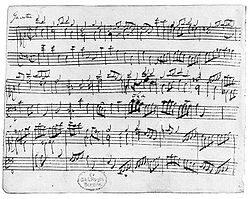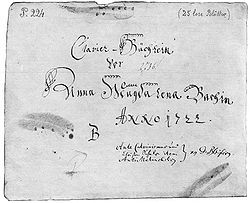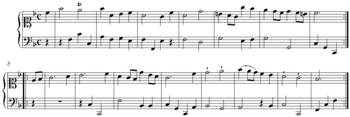
Notebook for Anna Magdalena Bach
Encyclopedia

Manuscript
A manuscript or handwrite is written information that has been manually created by someone or some people, such as a hand-written letter, as opposed to being printed or reproduced some other way...
notebooks that the German
Germany
Germany , officially the Federal Republic of Germany , is a federal parliamentary republic in Europe. The country consists of 16 states while the capital and largest city is Berlin. Germany covers an area of 357,021 km2 and has a largely temperate seasonal climate...
Baroque
Baroque
The Baroque is a period and the style that used exaggerated motion and clear, easily interpreted detail to produce drama, tension, exuberance, and grandeur in sculpture, painting, literature, dance, and music...
composer
Composer
A composer is a person who creates music, either by musical notation or oral tradition, for interpretation and performance, or through direct manipulation of sonic material through electronic media...
Johann Sebastian Bach
Johann Sebastian Bach
Johann Sebastian Bach was a German composer, organist, harpsichordist, violist, and violinist whose sacred and secular works for choir, orchestra, and solo instruments drew together the strands of the Baroque period and brought it to its ultimate maturity...
presented to his second wife Anna Magdalena
Anna Magdalena Bach
Anna Magdalena Bach was the second wife of Johann Sebastian Bach.-Biography:...
. Keyboard
Keyboard instrument
A keyboard instrument is a musical instrument which is played using a musical keyboard. The most common of these is the piano. Other widely used keyboard instruments include organs of various types as well as other mechanical, electromechanical and electronic instruments...
music (minuet
Minuet
A minuet, also spelled menuet, is a social dance of French origin for two people, usually in 3/4 time. The word was adapted from Italian minuetto and French menuet, and may have been from French menu meaning slender, small, referring to the very small steps, or from the early 17th-century popular...
s, rondeaux
Rondeau (music)
The rondeau was a Medieval and early Renaissance musical form, based on the contemporary popular poetic rondeau form. It is distinct from the 18th century rondo, though the terms are likely related...
, polonaise
Polonaise
The polonaise is a slow dance of Polish origin, in 3/4 time. Its name is French for "Polish."The polonaise had a rhythm quite close to that of the Swedish semiquaver or sixteenth-note polska, and the two dances have a common origin....
s, chorale
Chorale
A chorale was originally a hymn sung by a Christian congregation. In certain modern usage, this term may also include classical settings of such hymns and works of a similar character....
s, sonatas, preludes
Prelude (music)
A prelude is a short piece of music, the form of which may vary from piece to piece. The prelude can be thought of as a preface. It may stand on its own or introduce another work...
, musettes, marches
March (music)
A march, as a musical genre, is a piece of music with a strong regular rhythm which in origin was expressly written for marching to and most frequently performed by a military band. In mood, marches range from the moving death march in Wagner's Götterdämmerung to the brisk military marches of John...
, gavotte
Gavotte
The gavotte originated as a French folk dance, taking its name from the Gavot people of the Pays de Gap region of Dauphiné, where the dance originated. It is notated in 4/4 or 2/2 time and is of moderate tempo...
s) makes up most of both notebooks, and a few pieces for voice
Vocal music
Vocal music is a genre of music performed by one or more singers, with or without instrumental accompaniment, in which singing provides the main focus of the piece. Music which employs singing but does not feature it prominently is generally considered instrumental music Vocal music is a genre of...
(song
Song
In music, a song is a composition for voice or voices, performed by singing.A song may be accompanied by musical instruments, or it may be unaccompanied, as in the case of a cappella songs...
s, and aria
Aria
An aria in music was originally any expressive melody, usually, but not always, performed by a singer. The term is now used almost exclusively to describe a self-contained piece for one voice usually with orchestral accompaniment...
s) are included.
The two notebooks are known by their title page dates of 1722 and 1725. The title "Anna Magdalena notebook" is commonly used to refer to the latter. The primary difference between the two collections is that the 1722 notebook contains works only by Johann Sebastian Bach (including most of the French Suites), while the 1725 notebook is a compilation of music by both Bach and other composers of the era. It provides a nearly unparalleled glimpse into the domestic music of the 18th century and the musical tastes of the Bach family
Bach family
The Bach family was of importance in the history of music for nearly two hundred years, with over 50 known musicians and several notable composers, the best-known of whom was Johann Sebastian Bach...
.
The 1722 notebook: French Suites and miscellany

Theology
Theology is the systematic and rational study of religion and its influences and of the nature of religious truths, or the learned profession acquired by completing specialized training in religious studies, usually at a university or school of divinity or seminary.-Definition:Augustine of Hippo...
August Pfeiffer (died 1698) in the lower right corner of the title page:
- "Ante Calvinismus" is a shortened and misspelled title of Anti-Calvinismus, oder Unterredungen von der Reformierten Religion (literally "Anti-CalvinismCalvinismCalvinism is a Protestant theological system and an approach to the Christian life...
, or Conversations about the reformed religion"). - "Christen Schule item" refers to Pfeiffer's Evangelische Christen Schule ("Evangelical Christian School").
- "AntiMelancholicus" refers to Anti-melancholicus, oder Melancholey-Vertreiber (literally "Anti-melancholy, or [something or someone used to drive out the melancholy]").
The notebook contains the following works, most in Johann Sebastian's hand:
- Five keyboardKeyboard instrumentA keyboard instrument is a musical instrument which is played using a musical keyboard. The most common of these is the piano. Other widely used keyboard instruments include organs of various types as well as other mechanical, electromechanical and electronic instruments...
suiteSuiteIn music, a suite is an ordered set of instrumental or orchestral pieces normally performed in a concert setting rather than as accompaniment; they may be extracts from an opera, ballet , or incidental music to a play or film , or they may be entirely original movements .In the...
s. The first three are fragments of the pieces that are now known as the first three French Suites, BWV 812–814. The next two are complete suites, French Suites Nos. 4 and 5, BWV 815–816. The minuetMinuetA minuet, also spelled menuet, is a social dance of French origin for two people, usually in 3/4 time. The word was adapted from Italian minuetto and French menuet, and may have been from French menu meaning slender, small, referring to the very small steps, or from the early 17th-century popular...
s of suites 2 and 3 are separated from the rest of their respective suites and were most probably added at a later date by Anna Magdalena Bach (they are almost certainly in her hand), some time before 1725. - Fantasia pro organo, unfinished, BWV 573. A short organOrgan (music)The organ , is a keyboard instrument of one or more divisions, each played with its own keyboard operated either with the hands or with the feet. The organ is a relatively old musical instrument in the Western musical tradition, dating from the time of Ctesibius of Alexandria who is credited with...
piece, 12 complete barsBar (music)In musical notation, a bar is a segment of time defined by a given number of beats of a given duration. Typically, a piece consists of several bars of the same length, and in modern musical notation the number of beats in each bar is specified at the beginning of the score by the top number of a...
and the beginning notes of the 13th bar. - Air with variations in C minor, unfinished, BWV 991. The first 10 bars feature coherent two-part writing, but the remaining 35 bars only have one voice written out.
- “Jesus, meine Zuversicht”, chorale prelude, BWV 728. A brief (9 bars) piece in three voices, features two sections with repeats for each.
- “Minuet in G major”, BWV 841 (not to be confused with PetzoldChristian PetzoldChristian Petzold was a German composer and organist. He was active primarily in Dresden, and achieved a high reputation during his lifetime, but his surviving works are few...
's Minuet in G Major in the 1725 notebook). A short dance with simplistic two-part writing and two sections with repeats for each.
The 1725 notebook
The 1725 notebook is bigger than the 1722 one, and more richly decorated. Light green paper is used for the front cover, Anna Magdalena's initials and the year number "1725" are printed in gold. All pages feature gilt edgingGilding
The term gilding covers a number of decorative techniques for applying fine gold leaf or powder to solid surfaces such as wood, stone, or metal to give a thin coating of gold. A gilded object is described as "gilt"...
. Most of the entries in the 1725 notebook were made by Anna Magdalena herself, with others written in the hand of Johann Sebastian, some by sons Johann Christian
Johann Christian Bach
Johann Christian Bach was a composer of the Classical era, the eleventh and youngest son of Johann Sebastian Bach. He is sometimes referred to as 'the London Bach' or 'the English Bach', due to his time spent living in the British capital...
and Carl Philipp Emanuel
Carl Philipp Emanuel Bach
right|250pxCarl Philipp Emanuel Bach was a German Classical period musician and composer, the fifth child and second son of Johann Sebastian Bach and Maria Barbara Bach...
, and a few by family friends such as Johann Gottfried Bernhard and Johann Gottfried Heinrich.
Although the 1725 notebook does contain work composed by Johann Sebastian Bach, it also includes works by many other composers. The authorship of several pieces is identified in the notebook itself, while that of others was established by researchers. The composers of still others, including several popular songs of the time, remain unknown.
Here is a complete list of the pieces included, in order of appearance in the notebook:
- Keyboard partita in A minor, BWV 827. This is the third partita from Bach's set of Partitas for keyboard BWV 825–830, which was published in 1731 as the first volume of Clavier-Übung.
- Keyboard partita in E minor, BWV 830. This is the sixth partita from Bach's set of Partitas for keyboard BWV 825–830.
- Minuet in F major, BWV Anh. 113.
- Minuet in G major, BWV Anh. 114. Usually attributed to Christian PetzoldChristian PetzoldChristian Petzold was a German composer and organist. He was active primarily in Dresden, and achieved a high reputation during his lifetime, but his surviving works are few...
. - Minuet in G minor, BWV Anh. 115. Usually attributed to Christian Petzold.
- Rondeau in B-flat major, BWV Anh. 183. This piece is by François CouperinFrançois CouperinFrançois Couperin was a French Baroque composer, organist and harpsichordist. He was known as Couperin le Grand to distinguish him from other members of the musically talented Couperin family.-Life:Couperin was born in Paris...
and is best known under the original title: Les Bergeries. - Minuet in G major, BWV Anh. 116.
- Polonaise in F major, BWV Anh. 117a.
Polonaise in F major, BWV Anh. 117b. - Minuet in B-flat major, BWV Anh. 118.
- Polonaise in G minor, BWV Anh. 119.
- Chorale prelude “Wer nur den lieben Gott läßt walten”, BWV 691.
- Chorale setting “Gib dich zufrieden und sei stille” in F major, BWV 510.
- Chorale setting “Gib dich zufrieden und sei stille” in D minor, BWV 511.
Chorale setting “Gib dich zufrieden und sei stille” in E minor, BWV 512. - Minuet in A minor, BWV Anh. 120.
- Minuet in C minor, BWV Anh. 121.
- March in D major, BWV Anh. 122. Usually attributed to Carl Philipp Emanuel Bach.
- Polonaise in G minor, BWV Anh. 123. Usually attributed to Carl Philipp Emanuel Bach.
- March in G major, BWV Anh. 124. Usually attributed to Carl Philipp Emanuel Bach.
- Polonaise in G minor, BWV Anh. 125. Usually attributed to Carl Philipp Emanuel Bach.
- Aria “So oft ich meine Tobackspfeife” in D minor, BWV 515.
Aria “So oft ich meine Tobackspfeife” in G minor, BWV 515a. - Menuet fait par Mons. Böhm, by Georg BöhmGeorg BöhmGeorg Böhm was a German Baroque organist and composer. He is notable for his development of the chorale partita and for his influence on the young J. S. Bach.-Life:Böhm was born in 1661 in Hohenkirchen, near Ohrdruf...
. Not included in the BWV catalogue. - Musette in D major, BWV Anh. 126.
- March in E-flat major, BWV Anh. 127.
- (Polonaise) in D minor, BWV Anh. 128.
- Aria “Bist du bei mirBist du bei mirBist du bei mir is an aria in the Notebook for Anna Magdalena Bach. It was therefore attributed to Johann Sebastian Bach, but the melody is part of the Gottfried Heinrich Stölzel opera Diomedes, oder die triumphierende Unschuld that was performed in Bayreuth on November 16, 1718. The opera score...
”, BWV 508. This composition is probably the most well-known of the arias of the 1725 notebook. Its melody is by Gottfried Heinrich StölzelGottfried Heinrich StölzelGottfried Heinrich Stölzel was a prolific German composer.-Biography:Stölzel grew up in Schwarzenberg, Saxony in the Erzgebirge. From 1707 he was a student of theology in Leipzig, and of Melchior Hofmann, the musical director of the Neukirche. He studied, worked and composed in Breslau and Halle...
. - Keyboard aria in G major, BWV 988/1. Another well-known piece, this is the aria of the Goldberg VariationsGoldberg VariationsThe Goldberg Variations, BWV 988, is a work for harpsichord by Johann Sebastian Bach, consisting of an aria and a set of 30 variations. First published in 1741, the work is considered to be one of the most important examples of variation form...
, BWV 988. Christoph WolffChristoph WolffChristoph Wolff is a German-born musicologist, presently on the faculty of Harvard University. Born and educated in Germany, Wolff studied organ and historical keyboard instruments, musicology and art history at the Universities of Berlin, Erlangen, and the Music Academy of Freiburg, receiving a...
has suggested that this Aria was entered into the two blank pages of this book by Anna Magdalena later, in 1740.
- Solo per il cembalo in E-flat major, BWV Anh. 129. A harpsichord piece by Carl Phillip Emanuel Bach.
- Polonaise in G major, BWV Anh. 130. Possibly composed by Johann Adolph HasseJohann Adolph HasseJohann Adolph Hasse was an 18th-century German composer, singer and teacher of music. Immensely popular in his time, Hasse was best known for his prolific operatic output, though he also composed a considerable quantity of sacred music...
. - Prelude in C major, BWV 846/1. This is the first prelude from the Well-Tempered Clavier Book 1, with bars 16–20 omitted, most likely in order to make the piece fit in two pages.
- Keyboard suite in D minor, BWV 812. This is the first French Suite.
- Keyboard suite in C minor, BWV 813. This is an incomplete version of the second French Suite.

- Movement in F major, BWV Anh. 131. The handwriting looks like that of a child, and apparently the piece is an attempt to create a bass line for a given melody.
- Aria “Warum betrübst du dich”, BWV 516.
- Recitative “Ich habe genug” and aria “Schlummert ein, ihr matten Augen” (solo), BWV 82/2,3.
- Chorale setting “Schaff's mit mir, Gott”, BWV 514.
- Minuet in D minor, BWV Anh. 132.
- Aria “Wilst du dein Herz mir schenken” (subtitled Aria di Giovannini), BWV 518.
- Aria “Schlummert ein, ihr matten Augen”, unfinished, BWV 82/3.
- Chorale setting “Dir, dir Jehova, will ich singen” (version for choir), BWV 299.
- Chorale setting “Dir, dir Jehova, will ich singen” (solo), BWV 299.
- Song “Wie wohl ist mir, o Freund der Seelen”, BWV 517.
- Aria “Gedenke doch, mein Geist, zurücke”, BWV 509.
- Chorale “O Ewigkeit, du Donnerwort”, BWV 513.
See also
- Klavierbüchlein für Wilhelm Friedemann BachKlavierbüchlein für Wilhelm Friedemann BachKlavierbüchlein für Wilhelm Friedemann Bach is a collection of keyboard music compiled by the German Baroque composer Johann Sebastian Bach for his eldest son Wilhelm Friedemann...
- List of songs and arias by Johann Sebastian Bach from the 1725 Notebook for Anna Magdalena (BWV 508-518)
- The 1725 Anna Magdalena Notebook compositions in the Appendix of the BWV catalogue
- Anna MagdalenaAnna MagdalenaAnna Magdalena is a 1998 Hong Kong film starring Kelly Chen, Takeshi Kaneshiro and Aaron Kwok. It was the directorial debut of production designer Yee Chung-Man.-Title:...
, a 1998 Hong Kong film titled after the Notebook. Minuet in G is featured extensively throughout the movie

